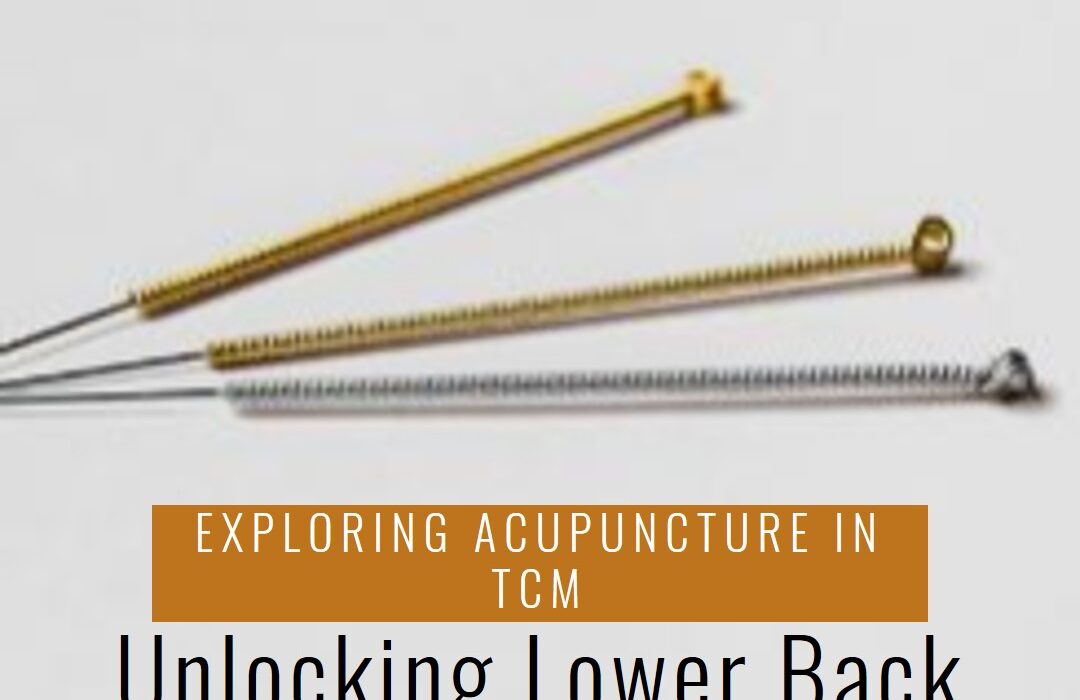Understanding How Acupuncture Points for Lower Back Pain Work in TCM

Introduction
Lower back pain is a prevalent health concern affecting millions worldwide, with numerous sufferers seeking relief beyond conventional treatments. One solution gaining popularity is acupuncture, a therapeutic approach deeply rooted in Traditional Chinese Medicine (TCM). This practice, based on a centuries-old philosophy, utilizes specific acupuncture points to alleviate discomfort, promoting overall wellness by addressing the body’s energy pathways or meridians. In this article, we delve into how acupuncture points for lower back pain work according to TCM principles, explaining the role of meridians, Qi (pronounced “chee”), and the body’s innate balance in providing effective, holistic relief.
How Does Traditional Chinese Medicine View Pain?
Within TCM, pain is often interpreted as an imbalance or blockage in the body’s energy flow, known as Qi. Qi flows through channels called meridians, which connect different organs and systems. When this energy is obstructed, stagnated, or insufficient in particular areas—like the lower back—pain and dysfunction can occur. Therefore, the purpose of acupuncture is to unblock, stimulate, or balance the flow of Qi within the affected meridians, which TCM believes supports the body’s natural healing abilities.
Common TCM Diagnoses for Lower Back Pain Include:
- Qi Stagnation: Blocked energy in the meridians.
- Kidney Deficiency: Weakness or imbalance in kidney energy, believed to contribute to chronic back issues.
- Blood Stasis: Poor circulation within the meridians.
- Cold and Dampness Accumulation: External environmental factors affecting energy flow in the lower back area.
Understanding these root causes is essential in TCM, as the practitioner tailors the treatment to address each individual’s unique constitution and symptoms.
Key Acupuncture Points for Lower Back Pain
There are several acupuncture points commonly targeted for lower back pain. Practitioners use these points based on TCM diagnostics, meridian theory, and experience. Here are a few significant points and their associated meridians:
- BL23 (Shenshu) – This point, located near the lower back, directly influences kidney energy, often considered essential for chronic lower back pain related to kidney deficiency.
- BL40 (Weizhong) – Situated at the back of the knee, BL40 is known for its effect on lumbar pain, reducing inflammation and relieving pain throughout the lower body.
- GV3 (Yaoyangguan) – Found at the midline of the lower back, GV3 addresses Qi stagnation and clears dampness from the meridians, especially useful for acute lower back pain.
- BL60 (Kunlun) – Located near the ankle, this distal point targets lower back pain through the bladder meridian, often employed to ease stiffness and reduce tension in the spine.
- GB30 (Huantiao) – In the buttock area, GB30 is a powerful point for sciatica and lower back pain, often used to relieve pressure and stimulate the body’s energy flow.
The Mechanism Behind Acupuncture for Pain Relief
Acupuncture’s effectiveness in pain management can be explained through TCM principles as well as scientific mechanisms. According to TCM, when a needle is inserted into an acupuncture point, it influences the flow of Qi along a specific meridian, re-establishing harmony and energy balance in the body. This restored flow promotes the body’s self-healing processes, resulting in pain reduction and improved function.
From a biomedical perspective, research shows that acupuncture stimulates the release of endorphins and enkephalins—natural painkillers produced by the body. Studies also suggest that acupuncture activates regions of the brain involved in pain perception, modulating the body’s response to pain. Moreover, acupuncture is found to reduce inflammation and improve blood flow, factors that are crucial for relieving pain and promoting tissue healing.
TCM and Evidence-Based Research
Over the years, various studies have validated acupuncture’s role in reducing chronic pain, especially in the lower back. A 2018 study published in the Journal of Pain analyzed multiple clinical trials and concluded that acupuncture significantly reduces pain intensity and improves functionality in patients with chronic lower back pain. Similarly, research funded by the National Institutes of Health (NIH) found that acupuncture could effectively manage chronic pain by activating specific nerve fibers that mitigate the perception of pain.
At Swissaccu, for instance, practitioners combine traditional TCM diagnostics with modern acupuncture techniques to deliver personalized treatments. Such an integrative approach has led to promising outcomes for those suffering from lower back pain. Offering a drug-free alternative to conventional pain relief methods.
Swissaccu’s Approach to Lower Back Pain
Swissaccu is known for its commitment to quality, emphasizing evidence-backed acupuncture techniques. Practitioners perform comprehensive assessments, identifying specific acupuncture points that will most effectively alleviate each patient’s lower back pain. Their methodology integrates classical TCM principles with modern insights into musculoskeletal and neurological functioning. By addressing each patient’s unique pain profile, Swissaccu supports long-term relief and improved quality of life.
Common Myths About Acupuncture Points for Lower Back Pain
Despite its popularity, several myths still surround acupuncture:
- Myth: Acupuncture is painful.
Fact: While slight discomfort is normal, most people find acupuncture relaxing. The needles are thin, causing minimal pain. - Myth: Acupuncture provides instant results.
Fact: While some feel immediate relief, others require multiple sessions for significant improvement. Consistency is key to seeing results. - Myth: Acupuncture only works if you believe in it.
Fact: Research has shown acupuncture’s benefits in pain relief, even in controlled studies with placebos. - Myth: Acupuncture is only for pain.
Fact: Acupuncture addresses a wide range of issues, including stress, digestive issues, and sleep problems.
Benefits of Acupuncture Points for Lower Back Pain
- Non-Invasive and Drug-Free: Acupuncture offers a safe alternative to pain medication and surgery, making it ideal for those seeking holistic care.
- Fewer Side Effects: Unlike medication, acupuncture has minimal side effects when performed by trained professionals.
- Personalized Treatment: Each acupuncture session is tailored to the individual, which may lead to more effective and sustainable results.
- Enhanced Mobility and Quality of Life: By reducing pain and inflammation, acupuncture can help improve mobility, allowing patients to engage in daily activities more comfortably.
- Supports Overall Health: Regular acupuncture sessions not only reduce pain but also contribute to a balanced, healthy state by addressing various body systems.
Frequently Asked Questions
Q1: How many acupuncture sessions are needed to relieve lower back pain?
Answer: It varies by individual, but many people see improvements within 6–12 sessions. Chronic cases may require ongoing treatment for optimal results.
Q2: Is acupuncture safe for everyone?
Answer: Yes, acupuncture is generally safe. However, it’s essential to consult a certified practitioner, especially if you have health concerns.
Q3: Can acupuncture be used with other treatments?
Answer: Absolutely. Acupuncture is often combined with physical therapy, chiropractic care, and other treatments to enhance outcomes.
Q4: How soon will I feel relief from lower back pain after acupuncture?
Answer: Some individuals experience immediate relief, while others may require a few sessions to feel noticeable changes.
Q5: Does insurance cover acupuncture points for lower back pain?
Answer: Coverage varies, but many insurance plans now include acupuncture. Check with your provider to confirm details.
Conclusion
Acupuncture offers a time-tested, effective approach to managing lower back pain by addressing the body’s energy balance and flow. Through the precise targeting of acupuncture points within the TCM framework, patients may experience reduced pain, enhanced mobility, and an improved sense of well-being. As scientific evidence supporting acupuncture continues to grow, more people turn to this holistic treatment for sustainable relief from chronic discomfort.
For those considering acupuncture points for lower back pain, consulting reputable providers like Swissaccu, who prioritize quality and personalized care, can make a significant difference. By blending ancient TCM practices with modern understanding, acupuncture remains a valuable asset for pain management and holistic health.
Also know about Complimentary And Alternative Therapies Such as Acupuncture










